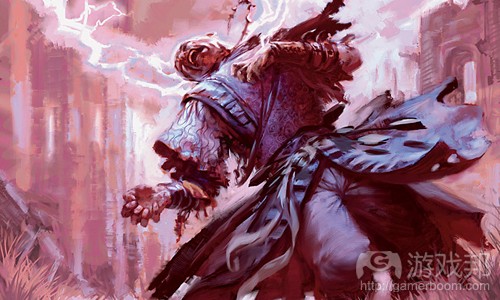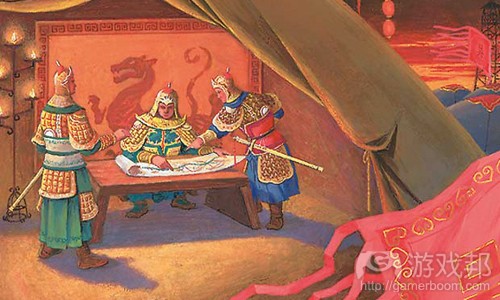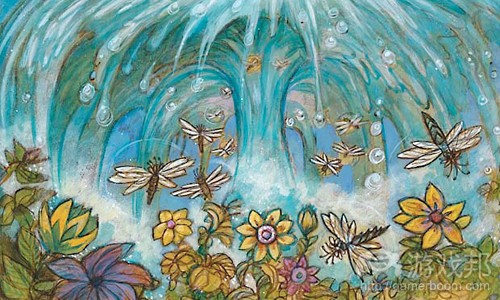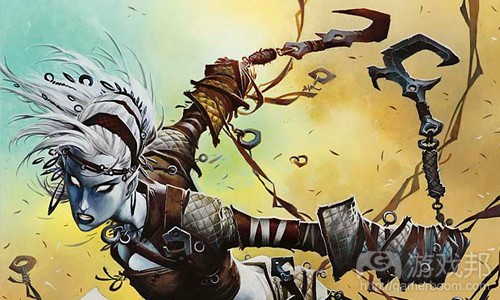分享好游戏必不可少的10大要素(下篇)
作者:Mark Rosewater
6)惊喜
你的游戏中需要一些能够让玩家预料不到的惊喜。人们总是喜欢惊喜。所以你必须确保自己的游戏拥有这种惊喜。(点击此处查看上篇内容)
为了精通掌握游戏设计,你必须先清楚怎么做才能吸引人们的注意。人们喜欢惊喜,特别是那种适当,不背离游戏环境,且能让人感到舒心的惊喜。
我之所以会觉得惊喜很重要,是因为人们有时候其实并不想知道未来会发生些什么。我们总是能够怀着一种激动的心情去面对一些未知的事物。当我们走进一款游戏时,这就是一个最佳的惊喜空间,只有身临其境,你才能感受到为何你想要获得惊喜。玩家总是喜欢享受惊喜。以下是另外两大原因。
另一个促使你在游戏中添加惊喜的原因便是我们所说的游戏深度。为了让游戏保持乐趣,你就必须让游戏保留一些玩家摸不透的内容。如果玩家能够一目了然地看穿游戏或者总是知道自己下一步该怎么做,那么他们便很快会对游戏失去兴趣。而适当的一些隐藏信息(能够为游戏营造出惊喜的内容)则会让玩家感到迷茫,因为这些信息会让玩家不知道如何做出决定。
同样地,一些隐藏信息也能够让一名玩家知道其他玩家所不知道的内容,所以这种方法不仅能够汇聚信息,而且能够让玩家更好地了解游戏。玩家可以通过线索(游戏邦注:即玩家在游戏中所做的或者在游戏中的反应)而做出一些相关推测并找出这些隐藏信息。比起游戏已经告知的内容,推测更有助于在游戏中营造出一种紧张感。
第三个原因便是惊喜能够提高游戏的重玩价值。游戏之所以能够带给玩家惊喜,是基于游戏本质属性,同时能够为游戏带来各种结果。当一款游戏拥有多种不一样的结果时,玩家更加愿意反复尝试游戏。
《Magic》中的惊喜则是来自于“文库”和“控制”。前者确保每一个游戏设置的不同,而后者则能够提供给玩家一些隐藏信息,并保持一种悬念。另外一个较大的惊喜则来自于随意安插的“咒语”和“功效”。而在《Innistrad》中便出现了“咒语”和“功效”这种惊喜,因而我们都能够在游戏中感受到一种恐怖的悬疑感。而《Innistrad》对卡片的使用让我们更加相信《Magic》未来的游戏设置将会更多地出现这种具有惊喜的设计空间。
7)策略
你的游戏中必须拥有一些能让玩家变得更好的内容。人们之所以愿意再次玩游戏是因为他们希望能够不断改进并完善之前的游戏知识,从而更好地将其运用于未来的游戏任务中。
有两大方法能够为游戏带来重玩价值。一个便是多样的游戏玩法。另一个则是游戏体验的持续性。我们总是很容易把玩游戏当成是单一的体验,但是事实上并非如此。就像是你玩1243款《Magic》类型的游戏与玩《Magic》有何不同?
游戏总是会从一个期间过度到另外一个期间(特别是角色扮演游戏),绝大多数游戏的开头和结尾其实是处在于两个完全不同的游戏片段中。而正是玩家在游戏中的行动将如此开头与结尾紧密联系在一起。当玩家越来越熟悉游戏,并且更加理解游戏,这种联系便会变得越来越成熟。也就是,如果玩家能够越频繁地玩游戏,便能够从中收获更多。
这种成长经验非常重要,游戏设计者必须赋予游戏与玩家一起成长的能力。而最简单的方法便是采用策略。在游戏中添加多种机会能够帮助玩家学习与成长。如果玩家在每次玩游戏时都能够完善自己的技巧并获得“升级”,那么他们肯定愿意经常玩游戏。
我之所以说到“升级”,是因为级别在很多游戏中都很重要。玩家要如何才能知道自己变得更好了?只能通过游戏提供给他们更多工具或资源而知晓答案。
《Magic》便很重视游戏策略。Richard通过各种深层次的策略元素而创造出这款多样化的游戏。在集换式卡牌游戏(玩家必须自己创造特别的游戏部件)以及亚对策(不断推出新卡片并改变旧卡片的格式)中添加策略元素,你将能够创造出一款具有策略性的高级游戏。
8)乐趣
游戏必须能够提供给玩家一些乐趣。玩家玩游戏的首要原因便是找乐子。如果你的游戏没有一点乐趣,那便没有人愿意尝试你的游戏。
当我在玩一款新游戏时(不只是指首次发行的游戏,同时也包括设计师首次推出的游戏),我们都会考虑到这10点必要因素,而乐趣则是其中很容易被忽视的一点。
在这十大元素中,乐趣可以说是最为主观的一点。一个人很容易喜欢上别人所讨厌的东西,但是游戏设计是关于创造乐趣的一种行为,所以每个游戏设计者都应该更加重视这一点。而因此,游戏测试不容忽视。虽然你能够从游戏观察中学到很多知识,但是乐趣却不在其中。乐趣来自于游戏体验,这就意味着设计游戏的一部分便是玩游戏,并且是由作为设计师的你与身份不明的玩家一起玩游戏(通常,与设计者存在个人交情的测试者总会对游戏给予好评)。
这对于游戏来说是最有效的验证方法。让一些不熟悉的人自由地玩你的游戏,而无需你的任何指导。然后在他们玩完游戏后,让其他人去问这些玩家一个问题,即是否愿意再次玩这款游戏?如果他们反馈的并非“我愿意”这种肯定回答,那就说明你的游戏便真的不够有趣。
《Magic》的乐趣在哪里?这是一个非常值得讨论的话题。《Magic》是否有趣?这是当然的!我是如何知道这个答案?因为我能够看到玩家的游戏方式。我看到玩家们会花10几个小时,甚至是1天以上的时间去玩这款游戏,如此之后,他们会更加热衷于玩《Magic》。他们愿意在不同社交媒体(游戏邦注:如Twitter,Facebook,Tumblr或者Google+等等)上玩这款游戏。可以说,几乎所有《Magic》玩家都愿意一直玩这款游戏。甚至在我们的研发部门中,我们每天的的工作也离不开玩《Magic》,而在下班后,我们也仍然会继续玩这款游戏。
我想,乐趣是所有游戏设计者都不能忽略的一点。因为如果游戏缺少了乐趣,玩家便不会愿意再次尝试这款游戏了。而这也是游戏设计中众所周知的一大真理。
9)基调
除了游戏机制,游戏同时还需要一种特别的吸引力。游戏需要属于自己的特定基调。有时候,设计者会先确定基调再围绕它开始设计游戏;也有时候,设计者会先明确游戏机制,再创造出符合这种机制的基调。不论设计者采取了哪种方法,只要游戏元素能够紧紧围绕着游戏故事或环境,游戏便会具有更多乐趣。
8年前,我曾经写过一篇文章,是关于基调在游戏设计中的重要性以及它的功能所在。而今天,我打算从另外一个角度去分析游戏基调。游戏设计者都有属于自己的游戏制作工具。但是我在此想要说的基调并不是一种工具,可以说,这是一种比工具更有效的方法。
首先,通过基调,你可以获得来自于玩家的情感反馈,并将这种反馈带到游戏中去。让我们以《Innistrad》为例。这款游戏体现出的基调是一种恐怖感。我们的设计团队并不是在创造恐怖,而是希望通过营造这种感觉而告诉玩家关于游戏的相关内容。我们能够创造出一些全新的氛围,并且不会让玩家对此感到陌生。在游戏设计中,基调是关于在情感层面上连接游戏与玩家的一种非常有价值的方法。
除此之外,基调还有更多功能。玩家玩游戏的最大阻碍是什么?也就是我们通常所说的“进入障碍”。为了让玩家玩你的游戏,首先你就必须教会他们如何玩。学习新事物是一个很难的过程,而如果你不能很好地教授玩家玩游戏,他们也许便不会再次尝试你的游戏。而进入障碍也许是《Magic》的最大肋骨。
基调能够帮助游戏降低进入障碍。基调能够以一种较为随意的方式为玩家解说游戏规则。基调能够帮助玩家明确游戏理念,更轻松地了解游戏,并鼓励他们更深入地学习游戏。基调可以说是进入障碍最大的天敌,俗话说得好,你敌人的敌人就是你的朋友。
基调还能够帮助你更好地完善游戏。我一直在讲述着游戏设计的重要性,但是吸引玩家玩游戏还有许多重要因素。游戏外观便是其中一点,而基调同时也能够很好帮助游戏完善外观。
《Magic》很好地利用了基调。这款游戏的主基调是关于魔法决斗。美术效果,名称以及基调描写等都是这款游戏能够吸引玩家的重要元素。很多人都表示,当第一次看到这款游戏的外观时,便深深为之着迷。而正如《Innistrad》所表现的,基调同时也能够帮助游戏定义背景。所以说基调是一个非常重要的“工具”,而《Magic》也很好地使用了这一工具。
10)诱饵
如果你希望人们玩你的游戏,你就必须先想出能够鼓励他们玩游戏的诱饵。而如果你正在销售游戏,那么诱饵指的便是你的营销方法。
起初,我认为诱饵只能用在游戏销售中,而并不在游戏设计者的考虑范围内。但是后来在仔细思考后,我发现设计者们其实也是在间接销售游戏。他们的游戏将会被区分等级,并且等待着玩家们对其做出反应。
按照这一标准,我们可以看出,其实游戏设计本身并不是一种艺术。单纯创造出一款游戏是远远不够的,你还必须学会如何去销售它。而如此,游戏设计者便必须学习这一标准了。游戏中必须具有能够用于市场营销的元素,而这包括多方面内容。可以是独特的游戏机制,具有创意的主题或者新颖的执行方法。不管设计者采取何种方法,都必须确保游戏能够吸引人们的眼球,让他们愿意停下来了解更多关于游戏的相关内容。
在我刚来到好莱坞之时,我认为成为当编剧最难的事情便是写出一部优秀的剧本。但是当我成为编剧作者后,我便发现写剧本不再是最折磨人的难事(尽管这仍然是一项很难的工作),最让我头疼的却是如何让观众阅读我写的剧本。在游戏设计中亦是如此。不管一款游戏如何优秀,如果它不能够吸引玩家进行尝试,那它便只能是一具没有灵魂的躯壳。
游戏设计者总是需要扮演着不同的身份,而其中之一便是市场营销者。你必须知道如何去销售你的游戏,因为这是你在设计过程中需要关注的一个要点。你不能只是创造出一款游戏而不去思考任何后续工作。因为如果你未考虑到这一点,你将会在创造过程中陷入一些不必要的麻烦,这与冰箱中未储存任何食物而在肚子饿了的时候却没东西吃是一个道理。诱饵能够帮助你创造游戏,而如果你忽视了它,便会面临巨大的麻烦。
最有益的诱饵是指简单而又容易理解的内容。诱饵必须能够抓住人们的注意,所以它就必须具备一些清楚易懂的信息。通常地,我们只有一次机会能够争取第一印象。所以你必须牢记,一定不要在诱饵中插入太多内容。诱饵的功能不是教育,而是吸引。它是用来帮助你吸引潜在玩家并鼓励他们了解更多关于游戏的内容。
而这也是《Magic》做得很好的一点,也是我们为何会在游戏中设置集换式卡牌的最主要原因。任何一张卡牌都带有一个很明确的基调,以及大篇幅的图像。而如此设置能够帮助游戏更好地抓住玩家的第一印象。但是对于《Magic》的设计者来说,游戏所面临的挑战便是即使拥有了一个很强大的诱饵,但是却还需要创造出更多不同的诱饵去拓展更大的市场。(本文为游戏邦/gamerboom.com编译,拒绝任何不保留版权的转载,如需转载请联系:游戏邦)
Ten Things Every Game Needs, Part 2
Mark Rosewater
#6) Surprise
There need to be elements of your game that the players cannot predict. People enjoy being surprised. You have to make sure that your game has moments that are unexpected.
One of the themes of my column is that to be good at game design you have to understand what makes humans tick. Humans love surprise, provided that it comes in the context of something that they are comfortable about. (One of these days I’m going to write an article all about my communications education and how it has defined how I view design. Comfort and surprise are two parts of what communication does to draw in an audience. Okay, now you’re all going, “But Mark, what’s the third piece?” Ironically, it’s completion. It’s going to be an awesome article.)
The reason I believe surprise is so beloved is that humans enjoy not always knowing what’s going to happen. There’s a thrill to the unknown. When you walk into a game, you’ve enter a comfortable space where it’s now okay to be surprised. That’s the psychological answer to why you want surprise. Player’s enjoy it. Now let’s get to the other reasons.
Reason two for wanting to add surprise to your game is what we call depth of play. To keep a game interesting for the players, you want for it to exceed their ability to understand what they have to do. If players can look at a game state and always know what to do next, the game will quickly become boring. Hidden information (the quality of a game which allows surprise to happen) makes it much harder to know what to do because it makes the decision tree infinitely more complex.
Also, hidden information allows one player to know something the other doesn’t, which brings information gathering and player reading to the game. Players can use clues (what the player did in the game or how they behaved or reacted to things) to make educated guesses as to what the hidden information is. Educated guesses make for much more in-game tension than definitive knowledge.
Reason three to want surprise is replayability. Games that have the ability to surprise are by their nature less consistent because in order to surprise someone, the game has to allow various outcomes. This results in games that have more variety to them and thus are more enjoyable to play again and again.
The key to Magic’s surprise is the library and the hand. The former makes sure each game plays out differently, and the latter provides hidden information to keep suspense during the game. The other big avenue for surprise is spells and effects with randomness built into them. Innistrad notched up those types of spells and effects because we found that the unknown helps create the suspense we wanted to capture the horror genre feel. The success of those cards in Innistrad (with the data we have so far) leads me to believe that future Magic sets might be more willing to play in that design space.
#7) Strategy
There needs to be something in your game that allows players to get better over time. The reason people like playing games again is that they want to use knowledge from past games to do better in future games.
There are two main things that provide replayability. One is variety of play. The other is the continuity of the experience. It’s very easy to think of each game played as a single occurrence in a vacuum but that’s not how it’s actually perceived. For example, have you played 1,243 games of Magic, or do you play Magic?
While some games continue from session to session (roleplaying games being the most famous example of this), most games start and end within each episode of play. What tends to tie them together is the relationship the player has with the game. As he or she plays more, this relationship matures most often through the player’s understanding of the game. Essentially, the more you play, the better you get.
Because this growth of experience is so important, game designers need to build into their game the ability for the game to grow with the player (and one could argue the player to grow with the game). The simplest way to do this is with strategy. Make the game have plenty of opportunities for players to learn and improve. If it does, this helps keep players connected to the game because each time they play they will improve their skills and “level up.”
I use the term “level up” because the idea of leveling is something that is so important that many games bring this aspect to the forefront. How do you know you’re getting better? Because the game shows you that you are, often giving you access to more tools or resources.
Magic nails this category. Richard created a very dynamic game system with deep strategic elements. Add to that the layering of a trading card game (where players have to construct the very game components they are playing with) and the ever-evolving metagame (with new cards constantly being released and old cards rotating out of formats) and you have a game about as strategically complex as has ever been created.
#8) Fun
There needs to be something that allows the players to enjoy themselves. The number-one reason people play games is for entertainment. If your game isn’t fun to play, people won’t want to play it.
I have played my share of first-time games (I’m not talking necessarily only about published ones, just games of which they were the first game the designer made) and of all ten categories, this is the one that is most often missed. That might come as a surprise, because at its core game playing is a form of entertainment. But many inexperienced designers (and one could argue some experienced designers) get so caught up in the minutiae of their games that they miss the most important question of all: Is the game fun?
Of all the ten criteria, fun is by far the most subjective. It’s very easy for one person to enjoy what another would hate, but game design is about creating fun experiences so this is something every game designer has to care about. This is where playtesting becomes so important. There is much you can learn by looking at your game, but fun is not one of them. Fun comes from the play itself, which means part of designing a game is playing—and not just by you, but by others, some of whom you shouldn’t even know. (Playtesters often sugarcoat reactions if they have a personal relationship with the designer.)
Here’s the best litmus test for a game. Have some people you don’t know play it without your guidance. When they are done, have someone (not you) ask them the following question: Would you want to play this game again? If you get anything other than a very enthusiastic “yes,” your game is not fun enough.
Why is Magic fun? That’s a topic worthy of its own column. Is Magic fun? Definitely. How do I know? Because I can watch the play patterns of the players. I have seen players play in a tournament for ten-plus hours and the second it’s over for the day, what do they do? They play more Magic. Pick a social medium of choice (Twitter, Facebook, Tumblr, Google+, etc.). Odds are I’m watching Magic players on it, and the common denominator on all of them is that Magic players really like to play and play a lot. Even in R&D where it’s our job to play Magic day in and day out, what do we do after hours? Play more Magic.
In my intro, I talked about how games can exist that skip one of the criteria (in the hands of an experienced game designer). There’s one, though, they can’t skip: this one. If a game isn’t fun, it will never get played more than once. That is the ultimate truism of game design.
#9) Flavor
Besides having mechanics, a game wants to have a trapping. It wants to be about something. Sometimes this comes first and the game is built around it. Sometimes the mechanics come first and a flavor is found to match it. Either way, games are more fun if the elements of the game refer a story or an environment or a theme.
Eight years ago, I wrote a column about the importance of flavor, and its role with function, in game design. The article makes a lot of good points so if you’ve never read it, I’d give it a look. Today, I will approach this issue from a different vantage point. A game designer has tools he or she uses to make a game. No tool, I will argue, is more potent than the tool of flavor. Let’s walk through what it can do.
First, it allows you to take emotional investment built by your players, usually through other means, and bring it to your game. Let’s use Innistrad as an example. The entire design of the set was to give mechanical flavor to the genre of horror. My design team and I didn’t invent horror, but by using it we were able to create something that spoke to our players at a very deep level. We were able to take something new and make it familiar. As game design is all about connecting with your player on an emotional level, that’s a pretty valuable tool.
But wait, there’s more. What’s one of the greatest obstacles to players playing your game? Something we call “barrier to entry.” In order for a player to play your game they have to first learn how. Learning new things is difficult and intimidating, and if you get turned off during that process, odds are you will never play that game again. Barrier to entry is probably Magic’s greatest weakness. (It’s both hard and very intimidating to learn.)
Flavor lowers barrier to entry. Flavor helps explain rules that might otherwise seem random. Flavor helps players lock onto ideas. Flavor excites the player making the material less intimidating and encouraging the player to learn. Flavor is barrier to entry’s greatest nemesis, and as they say, your enemies’ enemies are your friends.
Flavor also allows you to make your game look good. I spend a lot of time talking about the importance of game design, but there are many other facets that go into getting people to want to play your game. Appearance is a big one, and flavor helps tremendously with appearance.
Magic uses flavor well. The entire trapping of the game as a magical duel helps define how the game hangs together. The art and names and flavor text pull people in. A very common “I started playing Magic” story begins with someone entranced by the look of the game the first time they saw it. As Innistrad demonstrates, flavor can also help define a set or a block. Flavor is a very important tool which I feel Magic uses very effectively.
#10) A Hook
If you want people to play your game, there has to be something about it that encourages people to want to try it. If you’re selling your game, the hook is what you use to market it.
I mentioned in Part 1 that I originally had nine criteria and added a tenth one. This is it. The reason I initially left this one off was that this criteria is all about selling your game and the kids in the class didn’t have to worry about that. As I thought more about it, I realized that the kids were selling it, just not for a profit. Their games were going to be graded and a big part of that was going to do with how other students reacted to it.
This criteria plays up the fact that game making is not an art unto itself. It’s not enough to just make a game; you have to be able to sell it. To do this, the game designer has one more criterion to worry about. The game needs something you can market. This could be one of many things. It could be a unique game mechanic, it could be an original theme, it could be a novel execution. The key is that the designer has to make sure that there is something built into the game that makes someone stop and want to know more about it.
When I first arrived in Hollywood, I believed that the hardest thing about becoming a screenwriter was writing a good script. What I found out once I got there was that producing the good script wasn’t the hardest part (although to be clear, it’s pretty hard). The hardest part was getting the right person to read it. The same thing is true with a game. No game, no matter how good it is, can capture someone if they never play it.
A game designer has many hats, but one of them has to be a marketer. You have to be conscious of how you’re going to sell your game, because you have to make sure that it’s in the design. This element is so important that you can’t leave it up to chance. Can’t you just create your game and worry about it later? Maybe you’ll stumble upon in through the creation process. That’s kind of like never buying food and just hoping you’ll find something when you’re hungry. It could work out for you, but it could also end disastrously.
The key to a good hook is that it’s simple and easily understood. A hook has to grab a person’s attention and to do that it has to have a clear and digestible message. As they say you don’t get a second chance to make a first impression. Remember that your hook doesn’t have to explain much. Its role is not to educate but to tease. Its job is to make the potential player interested in learning more.
This is another criterion that Magic excels at, and the biggest reason is the nature of a trading card. Any single card has a strong flavor identity complete with a large illustration. It teases the larger game with text that might not make sense in a vacuum but clearly communicates there’s more going on than the observer can catch at first glance. The challenge for Magic designers is that while the game has a strong hook, we have to keep coming up with different hooks for each expansion.
Class Is in Session
The speech went over very well. I started by asking the kids to name their favorite games. For each point I used those games, as opposed to Magic as I did for these articles, to demonstrate my points. About six weeks later, the class held a Game Night where the students and their families could try out all the games the students had designed.
Rachel decided to base her game on the game Taboo.
The goal of the game, for those unfamiliar, is to get your teammates to name the noun in question without using any of the five taboo words or phrases. Seem easy? Here’s a sample card:
All the cards had to do with the American Revolution so it proved to be a little harder (especially for the parents) than normal Taboo. Rachel ended up getting an A (well, they didn’t have letter grades, but the equivalent of a high mark) on her game.
The Game Night was also a lot of fun as I got a chance to see all the different games the kids made. I was touched how many of the kids took my speech to heart and tried to incorporate the ten criteria into their game.(source:wizards)












































 闽公网安备35020302001549号
闽公网安备35020302001549号